Campervan awnings: a complete guide
An awning can extend the usable area of your campervan, giving you more room to relax, dine, or sleep. Our guide tells you everything you need to know
Page contents
- Introduction
- What kind of awning should you get?
- Poled or inflatable driveaway awning
- Fabrics for awnings
- How to attach a campervan awning
- Extras for campervan awnings
- Alternatives to campervan awnings
- Campervan awning showcase
- Our magazines
Words by Iain Duff
An introduction to campervan awnings
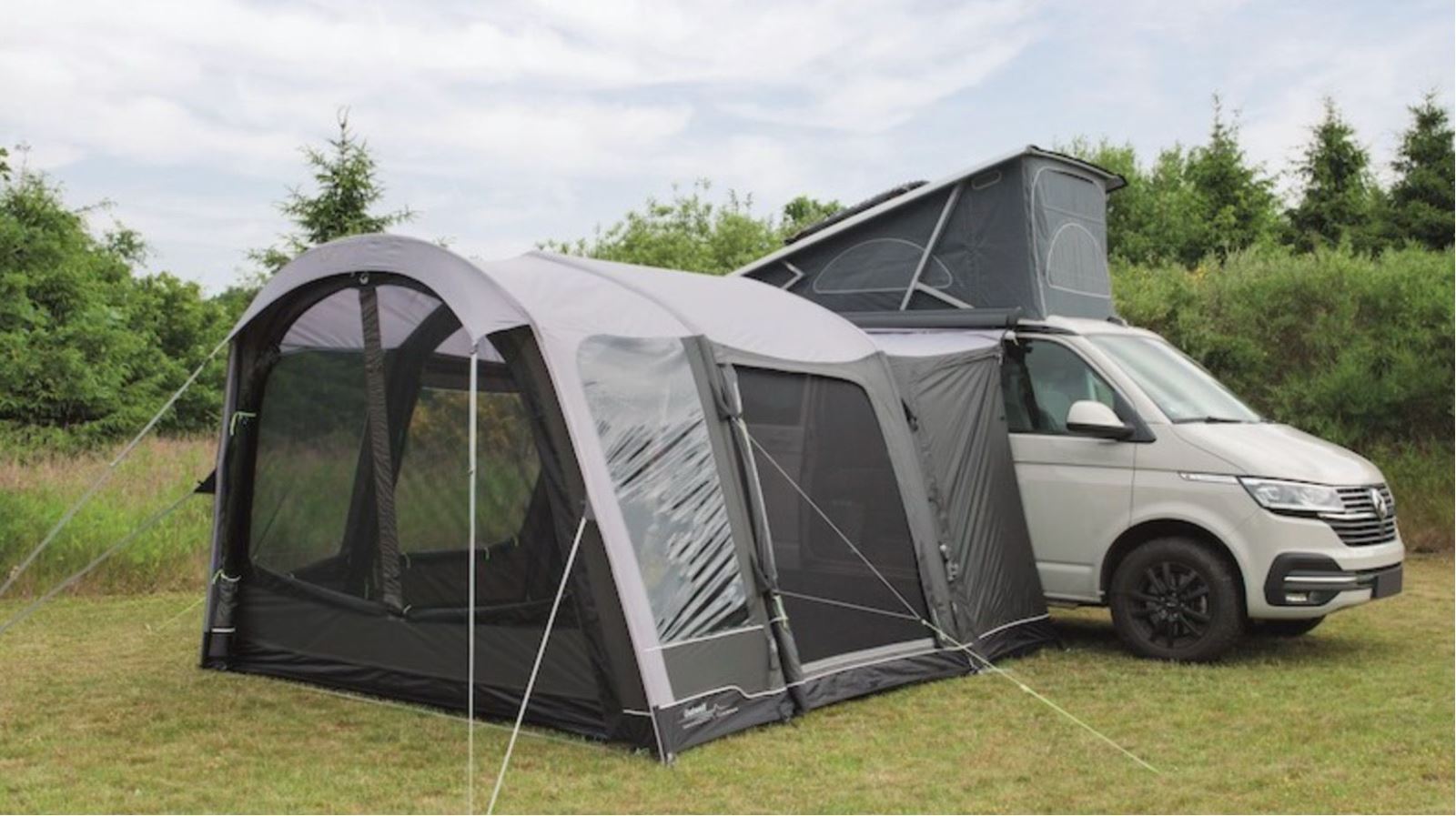
(Photo courtesy of Outwell)
One of the biggest advantages of campervans is that they make it so easy for you to head off for a spontaneous weekend break. Simply put everything you need into the back of the campervan and hit the road. And when you find the perfect spot, just pull over, quickly set up your bed and, before you know it, you’ll be asleep and dreaming about the next day’s adventures. But if you’re planning a longer trip or you’re travelling with the kids, it’s not quite so easy.
By definition, campervans often have limited interior living space, and while that can be a good thing in many ways – from space on your drive at home to being more confident driving a smaller vehicle in towns and on country lanes – it can also make life on the road tricky. Even with a double bed in a pop-top roof, squeezing four people into a smaller campervan is going to be a struggle.
And that’s where an awning can save the day – and the night – providing valuable additional living space alongside your campervan.
What kind of awning should you get?
Before you invest in a campervan awning, you need to think about how you travel and what you actually need an awning for. This will help you choose the type of awning to buy.
Will you be using it as an extra bedroom, or storage for outdoor gear, or just as a relaxing space? Do you move every few days and need something quick and easy to put up? Or are you likely to land on a destination, and set up camp for a week or two?
Once you have answered these basics then it is time to consider what type you need. For campervans, there are two main types of awning: pull-out cassette awnings and driveaway awnings.
Cassette awnings/wind-out awnings
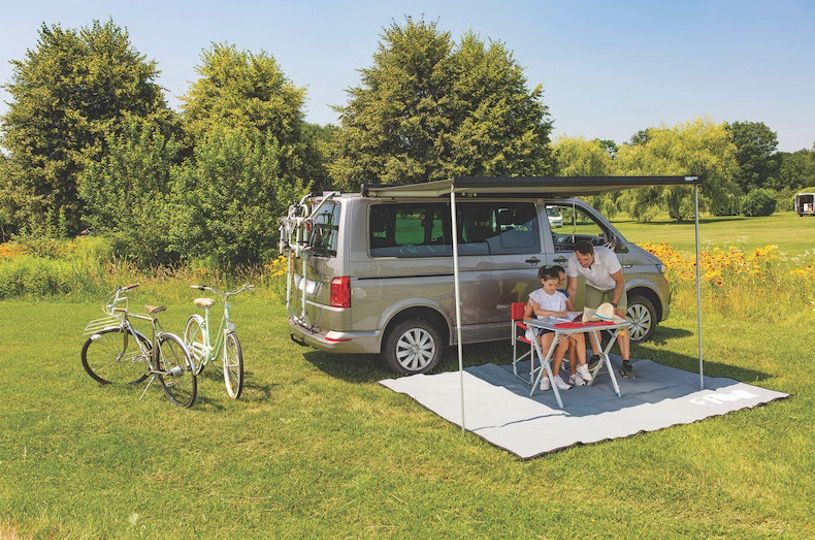
(Photo courtesy of Fiamma)
Cassette awnings are basically pull-out canopies fixed in a box on the side or roof of your campervan. These unroll from their housing using a crank handle or a motor. Simply unroll it then fold out the support legs and peg them down. Electric self-supporting (no need for legs) models are also available.
Wind-out awnings don’t take up storage space in your campervan, but they will eat into your available payload, some by as much as 50kg or more, so check first. These canopy awnings are great for people who move regularly as you can wind and unwind very quickly. They are primarily designed as something that lets you sit outside under shelter, but if you need a more enclosed structure then you can get accessories like side walls. You will have to remove those before you retract the awning and, of course, you’ll need to store them somewhere.
Because they are part of the structure of your vehicle, most campsites won't charge you extra to use a pull-out awning, but it is always sensible to check in advance to avoid any unexpected costs.
Among the leading brands who supply cassette awnings and accessories for campervans are Fiamma, Thule and Dometic.
If you don’t want to go to the trouble of fitting a wind-out awning, a more basic alternative is a simple sun canopy, which can be easily attached to the awning rail or channel on your vehicle and creates an effective sheltered space for sitting outside or cooking. Leading brands like Vango, Outwell, Outdoor Revolution, Reimo and Isabella all offer a good range of these canopies.
Both cassette awnings and sun canopies can be more susceptible to gusts of wind, so make sure you peg the legs down and fit storm straps and be prepared to retract them fully if the weather really takes a turn for the worse.
Driveaway awnings
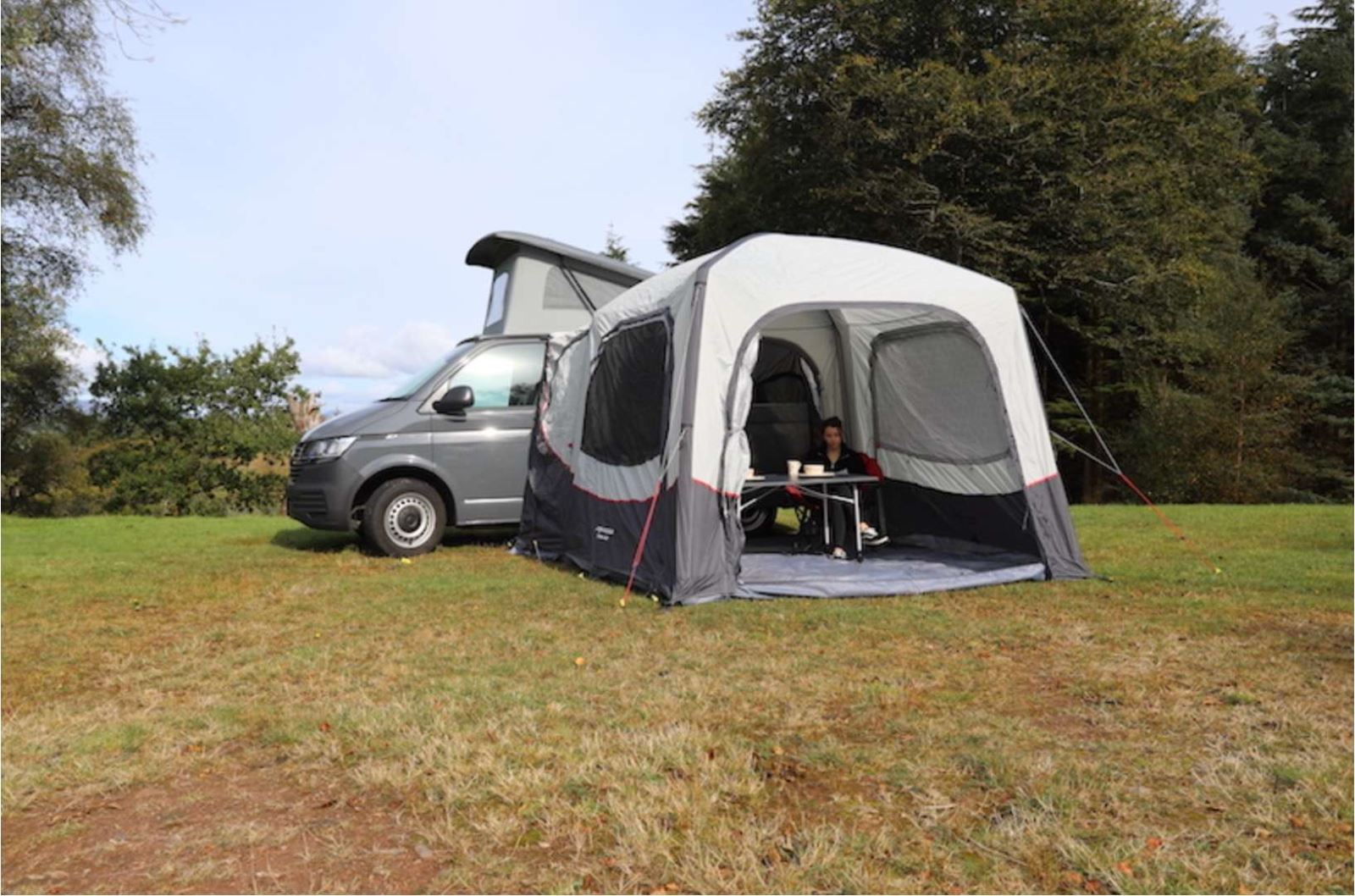
(Photo courtesy of Vango)
The most popular and practical style of awning for campervans, driveaways are free-standing structures that you can leave on site while you take the vehicle out for the day. If you’ve graduated from tent camping, you’ll instantly recognise the shape and design of the driveaway, as they are very similar to family tents.
However, as they are more like a tent, then you can use these almost like an extra room and they come in all sizes and shapes with various accessories like annexes, bedrooms and light fixings.
Awnings vary enormously in size, from small, basic models with just enough space for a couple of chairs and a table, up to very large ones with multiple bedroom pods. While it’s tempting to buy a big one that will cover all bases, campervans have limited amounts of storage, so you need to think about where the awning can be stored on the journey. Weight is another thing that will define your choice. If your payload and carrying capacity is limited, then look at a lighter polyester models, rather than the range of technical cottons and acrylics that are also available.
Driveaway awnings are versatile and can be used for various purposes. They can serve as a sheltered dining area, a place to store camping gear or bicycles, a children's play area, or even an extra sleeping space. Their flexibility allows you to adapt the awning to your specific needs.
Most driveaway awnings are designed for easy set-up and takedown, making them convenient for campervan owners. They typically feature lightweight materials, colour-coded or inflatable poles, and intuitive instructions, ensuring a hassle-free assembly process. This saves you time and effort, allowing you to quickly set up or pack away the awning when needed.
One of the key advantages of free-standing awnings is their ability to create a separate space while keeping the mobility of your campervan. Once the awning is set up, you can detach your vehicle and drive off for day trips, leaving the awning in place to secure your pitch. And, when you’re camping on busy or crowded campsites, they create a defined space that separates your living area from neighbouring pitches.
In the unpredictable UK weather, a driveaway awning provides protection from rain, wind, and sun. It acts as a shield, keeping you dry during showers and providing shade on sunny days. This allows you to enjoy outdoor activities or relax outside your campervan regardless of the weather conditions.
Most driveaway awnings attach to the side of your campervan but there are some that can be used at the rear (tailgate only, not barn doors).
Should you get a poled or inflatable driveaway awning?
Driveaway awnings are available in either poled (fibreglass or steel) or inflatable versions. Generally, inflatable awnings are considered quicker and easier to pitch, and that is certainly the case if you use a 12V compressor, rather than a hand pump, to do all the hard work. But poled awnings are cheaper, lighter and have a smaller packed size, and with a bit of practice can be pitched just as quickly as inflatable versions.
Remember to only use a compressor with a pressure that is no higher than the awning manufacturer allows.
Poles can break but air tubes can leak; although, in many cases, the air awning will be easier to fix in situ if you can locate the leak and use a repair kit.
What fabric should you go for in an awning?
Awning fabrics are a critical factor when buying. Materials used vary from lightweight, thin polyester to top-quality, solution-dyed acrylic. They can vary enormously in weight, look and feel and your choice will depend on how you’ll use the awning.
Look for fabrics that are tough, breathable and dry quickly and are protected against damaging UV light, as well as being tough enough to withstand strong winds and is both breathable and provides a degree of insulation.
Polyester is quick to dry after rain and is lightweight to handle when you’re constructing and packing it away. They’re less expensive than acrylic options but still provide good levels of waterproofness.
The next step up is polycotton – sometimes called technical cotton. This is a combination of natural and man-made fabrics and is more breathable than polyester, so creates less condensation. It’s also warmer in cold temperatures and cooler in hot weather. Finally, you have expensive, high-quality acrylic awnings, which are made to last many years. They look more taut and rigid than lighter-weight fabrics.
How do you fit a campervan awning?
You will need to consider how you are going to attach the awning to your campervan. Most manufacturers have fixing kits available as accessories but, if you are new to campervanning, ask your dealer what it recommends for your specific model.
Cassette canopy awnings are permanently fixed to the side or roof of a campervan. You can do this yourself, but before you start drilling holes in the vehicle’s bodywork, think about getting a professional to do the job. Most dealers and awning specialists provide a fitting service.
If you already have one fitted, but want something different, these can act as the attachment point for a whole host of other types of awnings. And you can get a kit that converts a 4mm channel to the necessary 6mm channel required for most driveaway awnings. If your driveaway awning isn’t compatible with your rail, you just get a keder adaptor, which are quite cheap.
If you have a steel-bodied campervan then there are magnetic strips with conversion points that fix to the roof. And if you have a rail or channel on your motorhome then you can get kits to attach the awning directly into it. This makes driving away difficult, so keder strips, or figure-of-eight attachments, come into play.
If you don’t have an awning rail on your campervan, you can attach guylines to the loops and peg down on the other side of the motorhome but this involves trying to get the guyropes over the vehicle and, on bigger models or campervans with pop-up roofs, this could prove difficult. Most driveaway models will come with a tunnel that connects the main body of the awning to the camper. The Coleman Journeymaster has a side door located in the tunnel, meaning you don’t have to walk through the awning to gain access to the motorhome, and this also means the tunnel could be used to store outdoor kit, bikes and muddy boots.
What extras do you need for campervan awnings?
Once you have decided which awning is right for you, there are the extras to consider:
- Have a selection of pegs to use in the different types of ground. While the metal pegs that are usually supplied with an awning are good enough for normal grassy pitches, you can buy pegs that are specially designed for hardstandings, sandy ground and very soft conditions.
- Breathable membranes for floors are also easily available.
- Many tent and awning manufacturers make lighting that has its own neat attachment points and most will use low-energy LEDs.
- Electric awning heaters will take the chill out of the air in the cooler months.
- Roof liners can add extra insulation, plus, you can get floor liners and carpets for underfoot.
- Inner bedroom tents and annexes are also available to make the extra space work better for you and your needs.
What alternatives are there to campervan awnings?
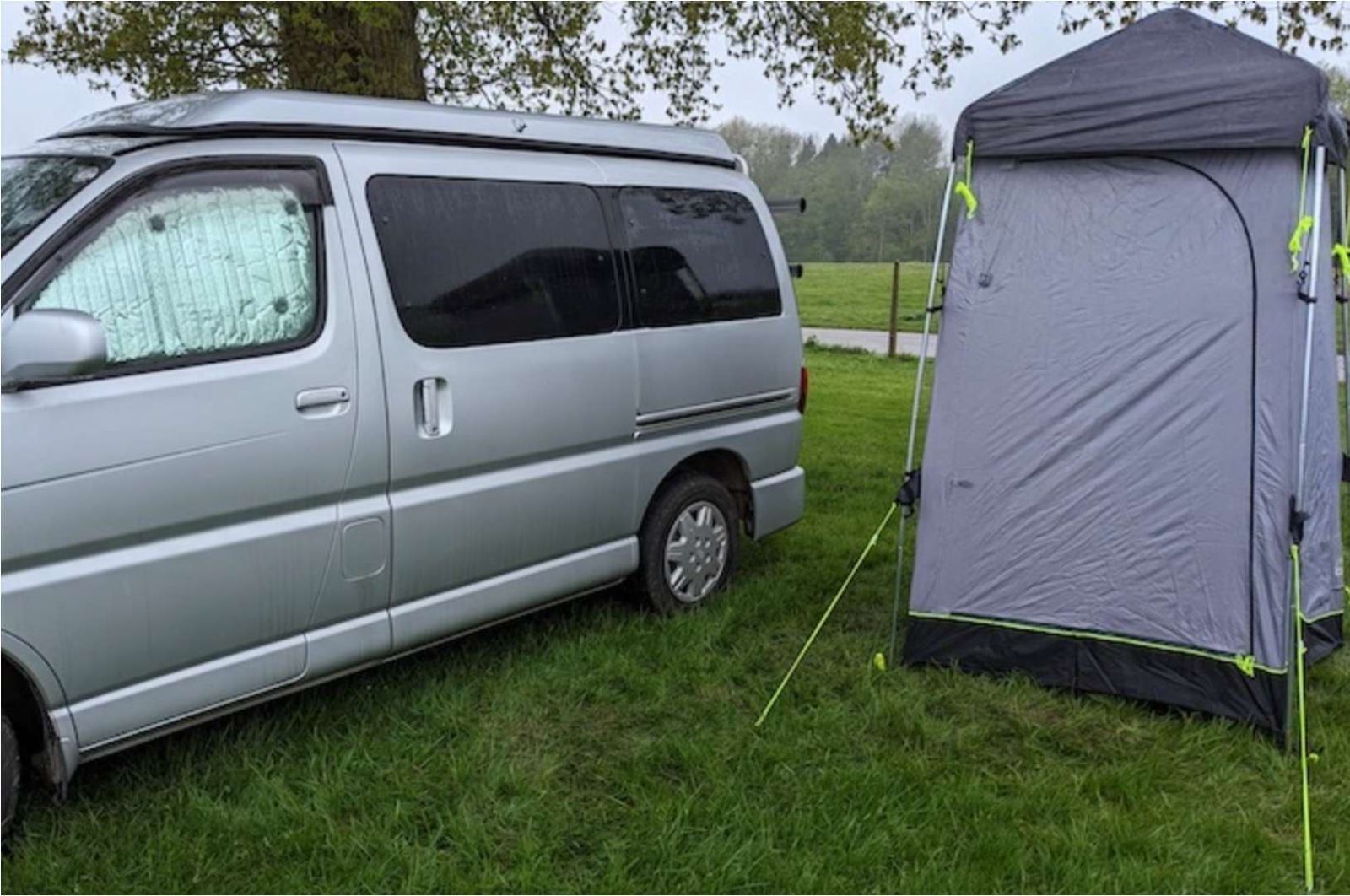
Camping tent
Small camping tents are a great alternative to awnings. If your kids have outgrown the campervan pop-top or their mates tag along occasionally, a little two or four-man ‘pup tent’ could be just the ticket. Make sure the campsite is happy for you to include one of these on your pitch.
Tipis and yurts
For extra living space, a tipi or yurt is another alternative worth considering. Not only do these provide living space and sleeping quarters, but they are also available with portable log burners and insulated carpets, making them ideal for winter camping.
Event shelters
Another option is a free-standing event shelter. Most of the major tent and awning manufacturers, like Coleman, Vango, Outwell and Outdoor Revolution, produce their own. These can be much cheaper than a cassette awning and they stay on site, thus marking your pitch. They are lighter, pack smaller and are quick to put up; many come with sides and doors as an optional extra to provide even more shelter.
Coleman and Outwell both have connectors that allow you to attach a shelter to your campervan, effectively converting it into an awning.
Toilet tents
Finally, consider a toilet tent. If you have a portable toilet in your campervan or are thinking of getting one, a toilet tent is a wise investment – the alternative is that everyone else has to get out of the campervan and stand outside when anyone needs the loo!
Toilet tents are small and lightweight, so they don’t take up much room, and are easy to put up. Kit it out with a hanging lamp, a loo roll and a bottle of hand sanitiser, and you’re sorted.
Campervan awning showcase
Here is a selection of different types of campervan awning available in 2023
Fiamma F45s
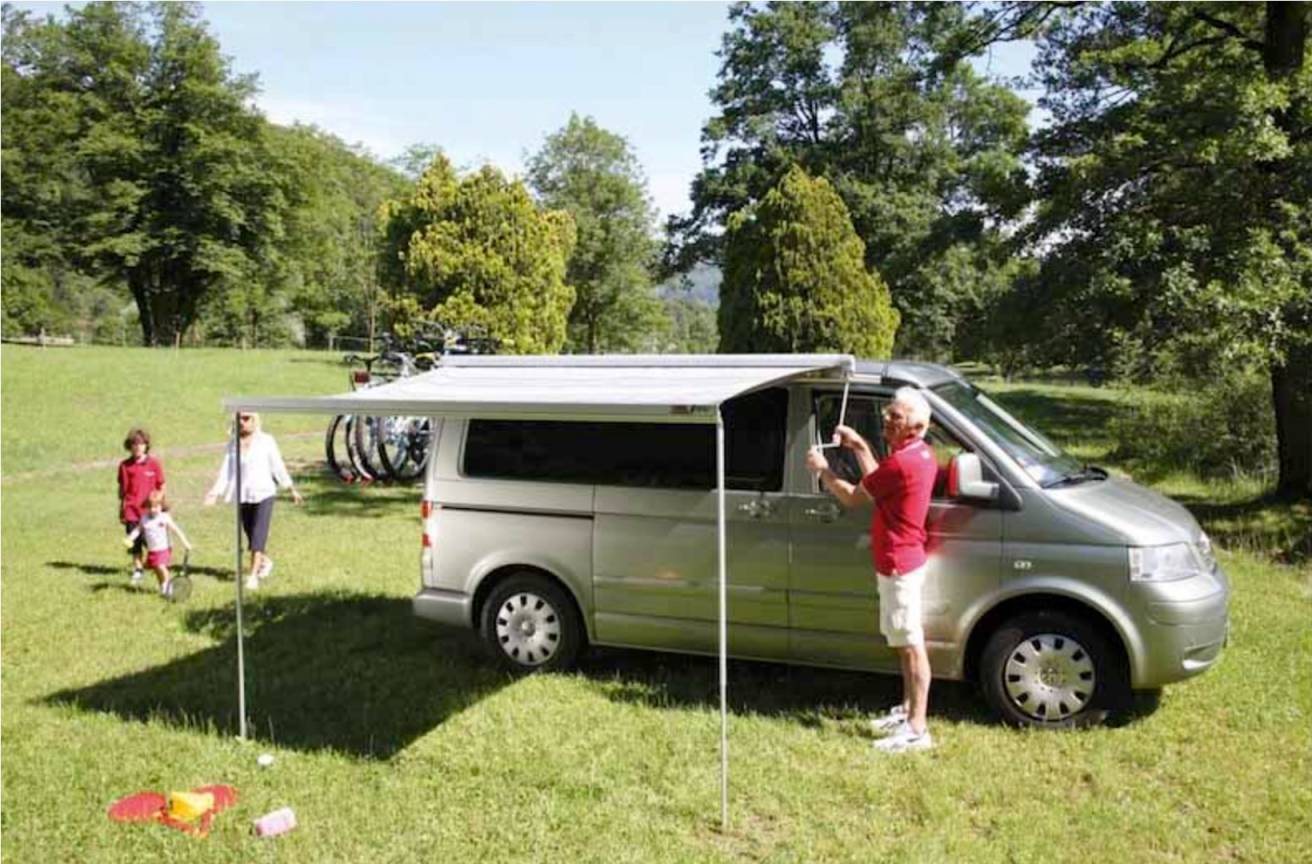
(Photo courtesy of Fiamma)
If you’re looking for an easy-to-use shelter to create a covered area where you can sit outside your campervan, day or night, then this Italian-designed cassette awning is the ideal option. Once fitted to the side of your vehicle, the vinyl canopy opens and closes with a winch handle to quickly create a sheltered space.
When it’s not in use, the F45s remains hidden away in its aluminium case, attached to the outside of your campervan. If you want a more enclosed space, there is the option to add a privacy room and it comes in a variety of colours. There is a wide range of sizes available, designed to fit different campervan models.
Price: £689
W: fiamma.it
Coleman Journeymaster Deluxe Air XL BlackOut
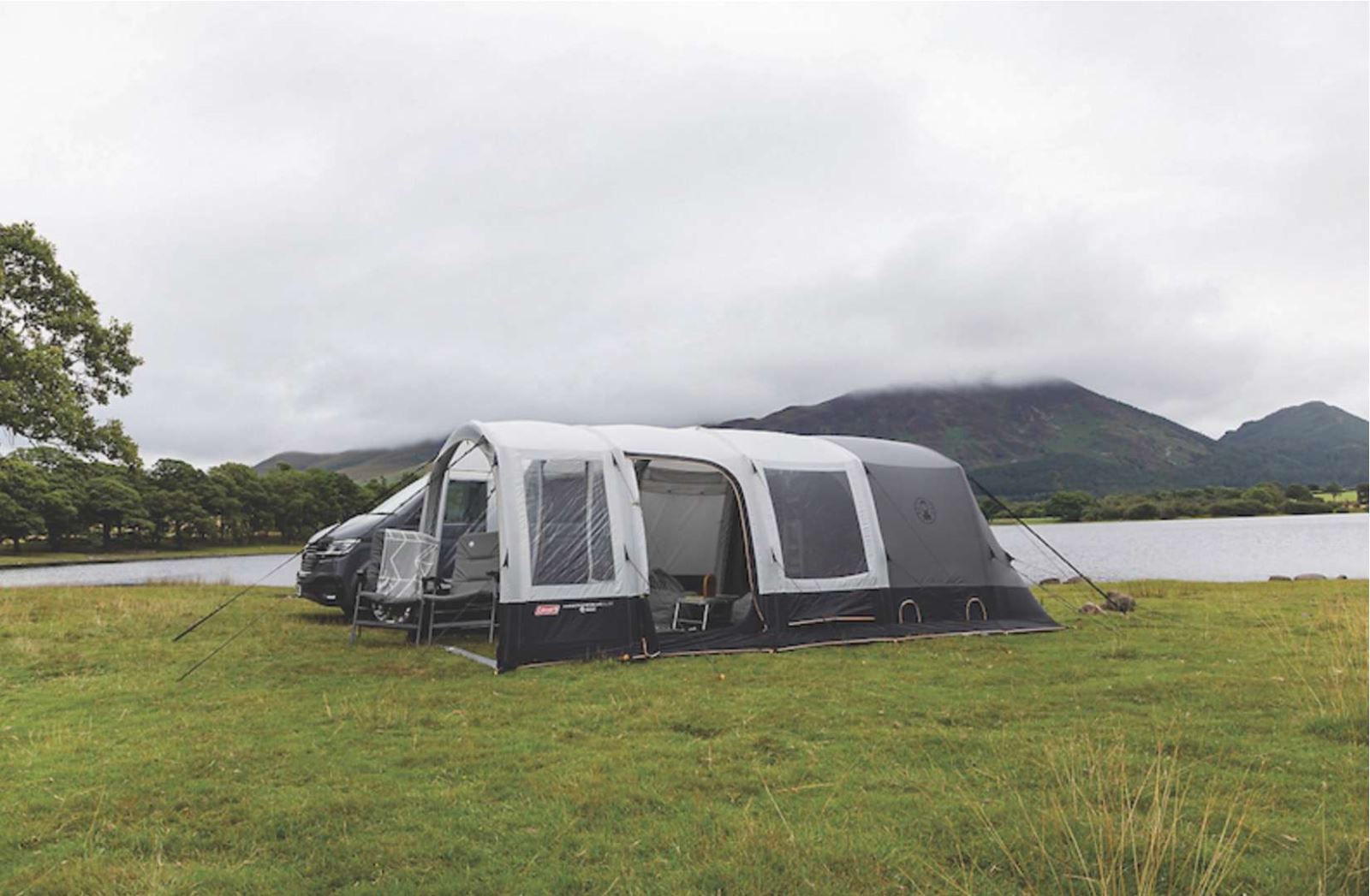
(Photo courtesy of Coleman)
This family-sized awning is the first to feature Coleman’s award-winning BlackOut Bedroom technology, which blocks up to 99% of daylight from the sleeping area. The pre-attached bedrooms sleep four, are extra-large and will comfortably fit larger airbeds.
The BlackOut material blocks daylight, so you aren’t awakened as soon as the sun rises, and helps regulate the temperature in the sleeping area. Quick and easy to pitch thanks to the FastPitch Air inflatable poles, it has a large, bright living area and an extended porch, with a drop-down doorway, to reduce trip hazards.
Price: £1,199.99
Vango Magra Air VW
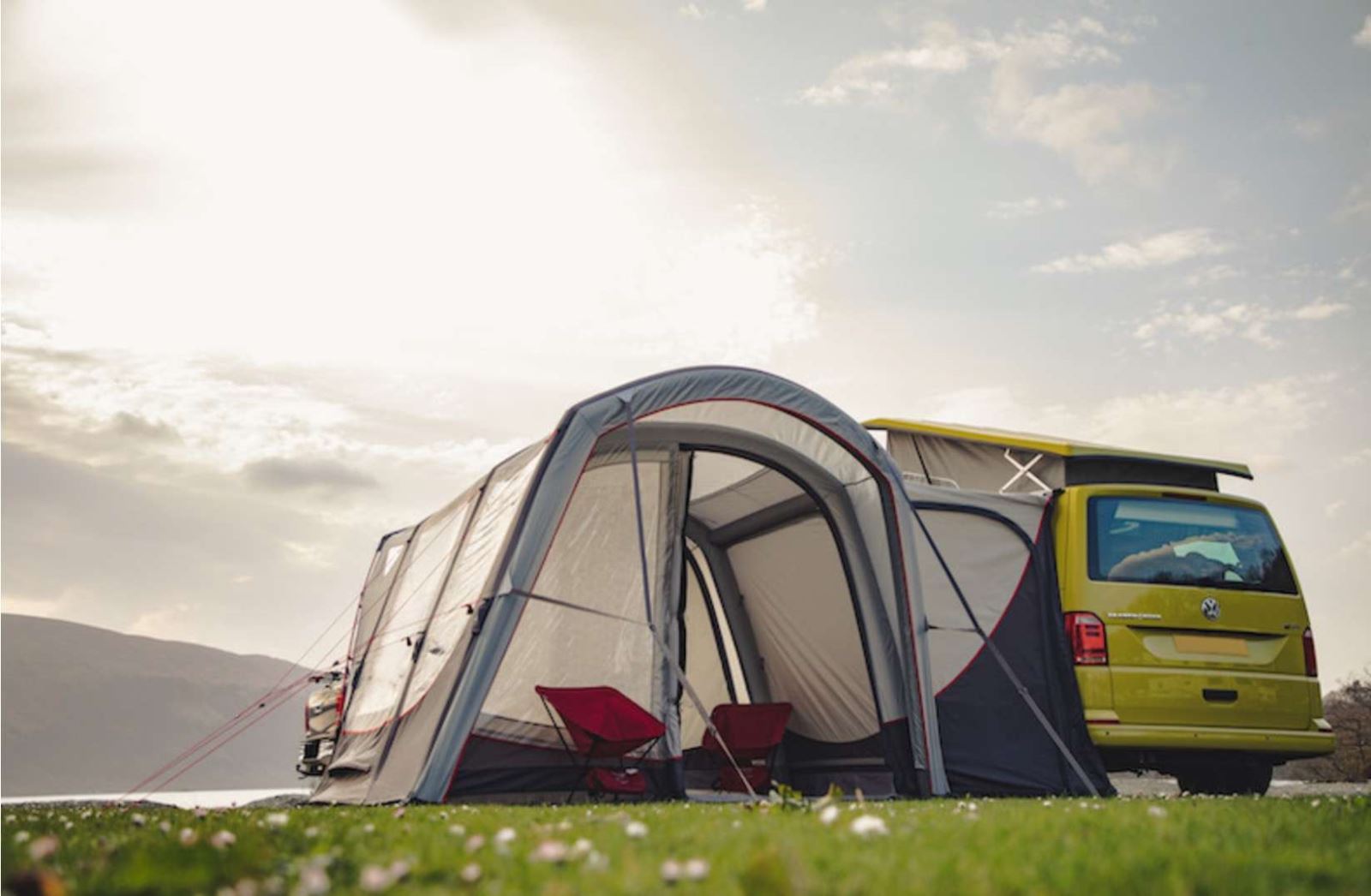
(Photo courtesy of Vango)
The Magra Air VW is an inflatable driveaway awning designed to fit medium-sized campervans, such as the VW T6. It can be used on campervans with either a left or right-hand side sliding door, which is handy for VW California owners.
It’s made from lightweight but durable fabric, so you get a good weight-to-awning-size ratio, and there’s lots of space to store your biking or surfing gear, while still having plenty of room to chill out. With front and back doors, access is easy, too, and you can add a bedroom pod as an optional extra, for more sleeping space.
Price: £955
W: vango.co.uk
Outwell Beachcrest
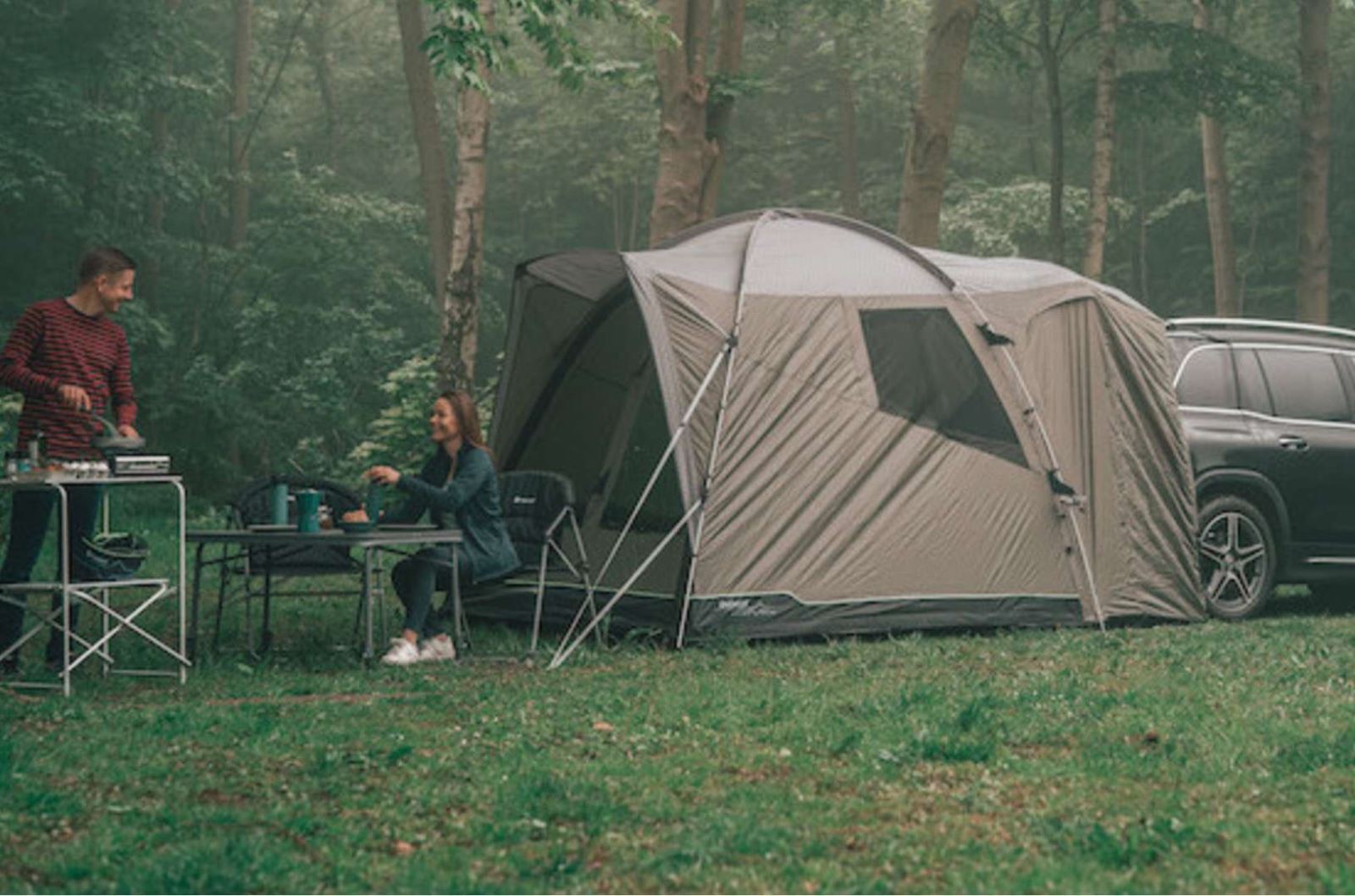
(Photo courtesy of Outwell)
The Beachcrest is a poled tailgate driveaway awning, which features a rather innovative design. In driveaway mode, it looks like an ordinary free-standing dome tent but when you want to attach it to your campervan, you simply unfurl a tunnel at the back, which is supported by the tailgate.
It is suitable for smaller campervans (attachment height is 155cm to 185cm) and includes a large two-section front door fitted with flyscreens, tinted windows and rain shelter, and side windows also fitted with flyscreens and waterproof curtains. A sleeping pod can be added inside, too.
Price: £730
W: outwell.com
Outdoor Revolution Movelite T4E PC
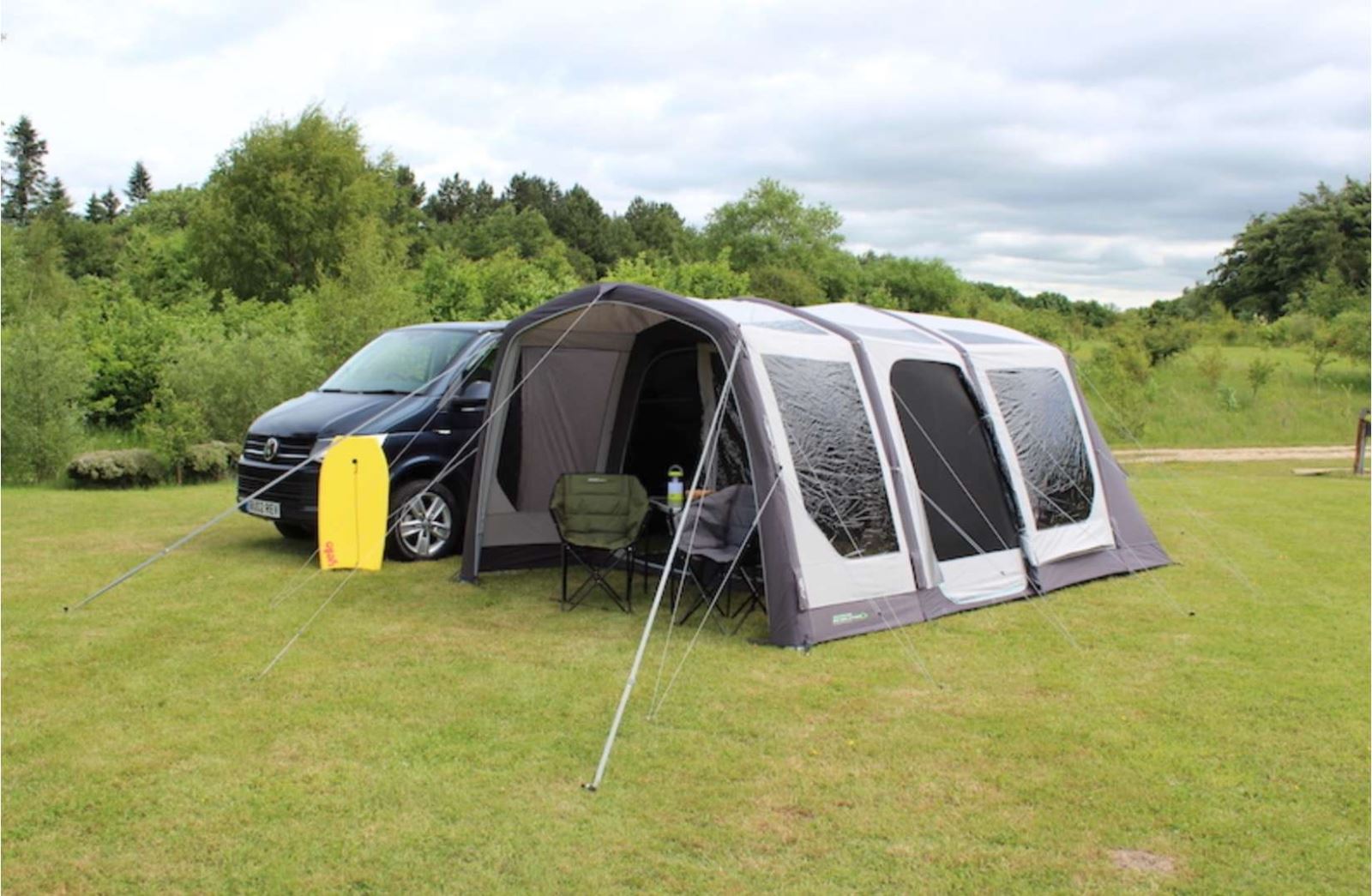
(Photo courtesy of Outdoor Revolution)
The flagship of Outdoor Revolution’s driveaway awning range is made from a sumptuous, breathable polycotton fabric. It is a premium driveaway awning, that sits alongside your campervan and provides living accommodation for up to four people. Inner sleeping annexes for two or four are available to buy separately.
The Movelite range has Outdoor Revolution’s DSV inflation valve and IF pressure relief valve. The DSV expels the air from the tubes in a matter of seconds with the press of a button and the IF valve automatically releases air if the pressure inside the inflation tube increases on hot days.
Price: £1,149
Isabella Air X-Tension
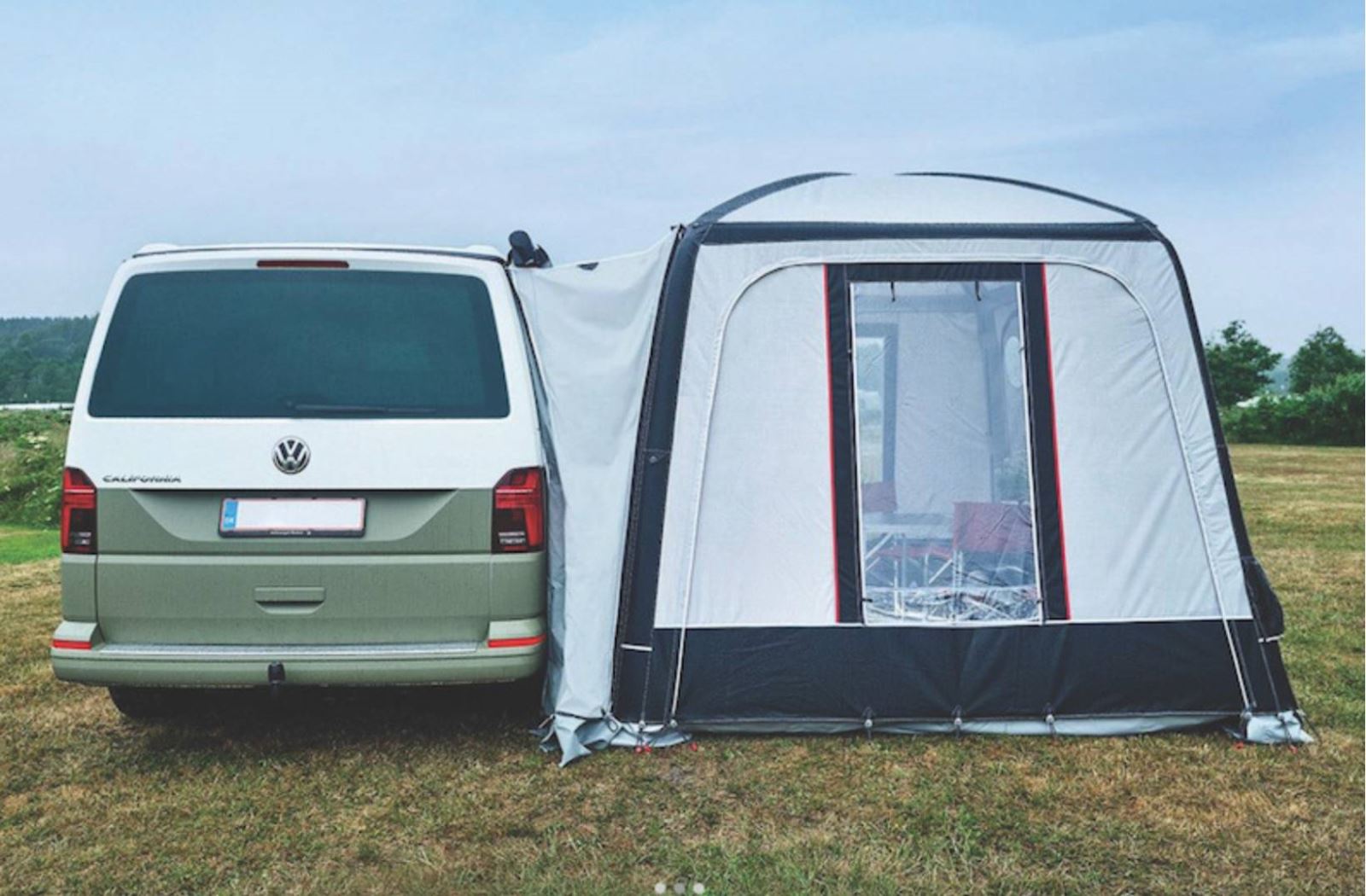
(Photo courtesy of Isabella)
The Air X-Tension was launched in 2022 and is an inflatable driveaway awning that is great for use at any time of year, as three of the sides can be completely removed or rolled back in hot weather, but then you can fully batten down the hatches on wet or chilly days. It’s quick and easy to pitch and pack away, which makes it ideal for road trips where you are on the move every day.
Features include net windows for ventilation and roll-down blinds, and a specially developed connection tunnel that ensures a snug fit to a VW T4, T5 or T6 campervan, including the VW California, and it’s compatible with other models of campervan of a similar size, too. It connects using an awning rail.
Price: £1,249
W: isabella.net
Expert motorhome advice to your door!
Why not subscribe to one of our fabulous magazines and get expert advice, travel ideas, technical help and all the latest news for your motorhome and your motorhome adventures!

Want to know more about MMM magazine?
Every month MMM has articles written by motorhomers who have been there and done it, from great UK and European (and further afield) tours, campsite reviews, owners' reports and DIY projects among other things.
MMM's tests, reviews and expert buying guides are not to be missed. MMM's technical advice is a must and includes everything from weekend jobs to longer-term DIY projects. And much more!
About MMM magazine
Want to know more about What Motorhome magazine?
Every issue of What Motorhome magazine provides essential buying advice for anyone looking to buy a new motorhome or campervan or upgrade their existing model. With a pedigree of over 30 years of offering the best motorhome and campervan buying advice, every issue of What Motorhome includes more new motorhome and campervan reviews than you will find in any other magazine.
About What Motorhome
Want to know more about Campervan magazine?
Campervan is the exciting monthly magazine that will give you all the inspiration you need to explore the world in your campervan. Every issue is packed with real-life campervanning experiences, inspiring travel ideas in the UK and further afield, the best campsites to stay on, campervan road tests and reviews of the latest models, and much more!
About Campervan magazine







Recent Updates
Engine management lights: all you need to know
What is the engine management light? What does it mean, and what do I have to do? ...
Motorhome air suspension: all you need to know
Motorhomes are heavy and the additional weight of equipment and height of the bodywork can increase the loads ...
Motorhome WiFi: how to get better motorhome internet
Staying connected on the move is more and more essential, so relying on campsite WiFi isn't an option – here ...
A class of their own - our guide to A-class motorhomes
Thinking of trading up to an A-class, or even going straight to the top of the motorhome tree? We guide you ...
Explore overseas on a motorhome dream tour
Enjoy exotic travel in a campervan or motorhome by hiring, swapping with someone else or exporting your ...
Motorhome water systems: everything you need to know
On-board water is an important part of every motorhome – here’s everything you need to know ...
Campervanning in Europe: what you need to know
Whether you're planning a leisurely drive through the French countryside, navigating bustling city streets in ...
Campervan security: all you need to know
With thefts on the increase, it’s important to know how to keep your campervan secure and prevent campervan ...
Campervan furniture: everything you need to know
Our campervan experts guide you through all the essentials for your campervan, including tables, chairs, ...
Campervan finance: how to fund your purchase
Here we look at the different types of campervan finance available, to help you decide what’s the best option ...
Other Articles
Britain’s best used motorhomes
Want a great motorhome without paying the premium for a new one? Here's a guide to the best you can get in the pre-owned market for each layout, ...
Which motorhome? Choosing the perfect motorhome for you
Choosing a motorhome or campervan is one of the biggest buying decisions you’ll ever make, so it's important ...
Campervan washroom essentials: stay fresh on the road
Our guide will take you through the campervan washroom essentials you'll need so you're well-prepared for ...
Dogs in campervans: all you need to know
Follow our advice and your dog will enjoy campervanning as much as you do ...
Electric campervans: all you need to know
Our guide will take you through everything you need to know about electric campervans and what the future ...
Motorhome electrics: a complete guide to your motorhome electrical set-up
Motorhome electrics can dramatically enhance the convenience and comfort of your vehicle – but they can be ...
Lighting for campervans: all you need to know
We guide you through all the lighting options available for you and your campervan, including interior ...
Electric bikes for motorhomes: our ultimate guide
Read our comprehensive guide to electric bikes for motorhome owners, helping you add electric power to your ...
Our guide to 'cheap' motorhomes in 2024
If you're on the hunt for an affordable new motorhome, this is the best place to start – we've rounded up a ...
Campervans in winter: all you need to know
Here's your guide to preparing your campervan for the colder months, whether you will be using it or putting ...